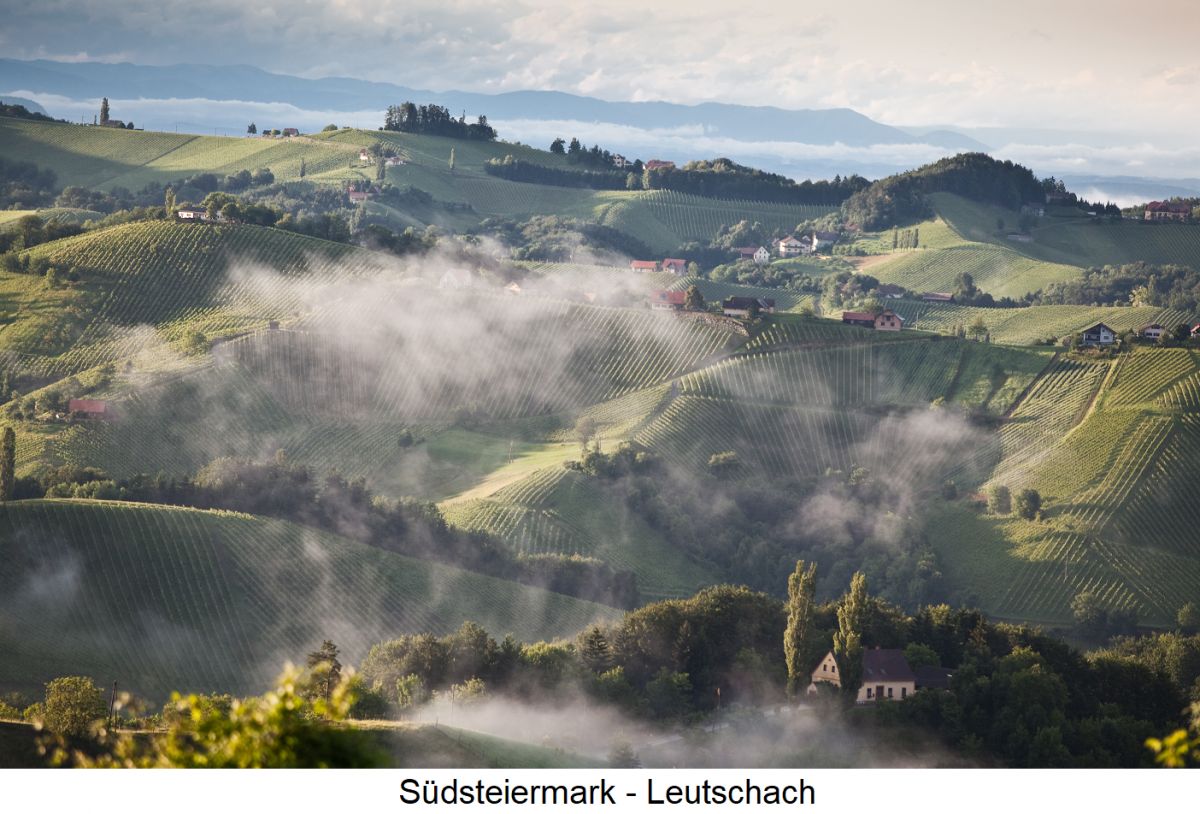Since the 2018 vintage, wine-legally defined DAC area (specific wine-growing region) in the Austrian wine-growing region of Styria (generic wine-growing region). See under Südsteiermark.
Southern Styria
By far the largest of the three specific wine-growing regions in the Austrian province or generic wine-growing region of Styria in terms of area. The history of viticulture dates back to the fourth century BC. In the monarchy towards the end of the 19th century, there were still 35,000 hectares of vineyards in what was then known as Lower Styria - roughly 15 times as many as today. At that time, however, areas now located in Slovenia were included. The Habsburg Archduke Johann (1782-1859) set the course for Styrian quality viticulture here by founding an experimental vineyard near Marburg (Maribor). The Pinot Blanc from the Jerusalem vineyard, now located in Slovenia, was one of the most sought-after white wines in Europe at the time and was served at many stately courts.

Climate & soils
The climate is characterised by Pannonian and southern European influences. The amount of precipitation is twice as high as in Burgenland and Lower Austria. The warm and humid weather favours the spread of botrytis for the production of noble sweet wines. Slate, sand, marl and limestone soils predominate. The sandy-clayey, tegel-like sedimentary rock, often mixed with shell limestone, is known as Opok in southern Styria.

Wine-growing communities
The region is divided into an area on the Slovenian border and the Sausal region to the west of Leibnitz. The Sausal slopes at up to 650 metres above sea level have a gradient of up to 42° (90%) and can sometimes only be cultivated using cable winches. These vineyards are laid out in terraces with retaining walls and steps. They are among the steepest vineyards in Austria. Well-known wine-growing communities are Berghausen, Ehrenhausen, Gamlitz, Heimschuh, Kitzeck (wine-growing museum), Leibnitz, Leutschach, Silberberg (wine-growing school), Spielfeld, St. Andrä im Sausal and Sulztal. These are connected by the South Styrian Wine Route, the Sausal Wine Route and the Rebenland Wine Route (also known as the Klapotetz Wine Route).
Well-known vineyards are Altenberg, Annaberg, Anzried, Berggericht, Czamillonberg, Eckberg, Eichberg, Einöd, Gaisriegl, Goldes, Graf, Grassnitzberg (Subrieden Grassnitzberg, Hochgrassnitzberg, Mittelplatsch), Harrachegg, Hochberg, Kaiseregg, Kittenberg, Koregg, Kranachberg (Subrieden Jägerberg, Oberfahrenbach, Rotriegl), Kreuzberg, Langriegel, Nussberg, Obegg, Oberglanzberg, Pfarrweingarten, Pössnitzberg (Subrieden Krepskogel, Römerstein), Schlossberg, Schusterberg, Sernauberg, Sgaminegg, Speisenegg, Steinbach, Stermetzberg, Sulz, Trebien, Wielitsch, Wilhelmshöhe, Witscheinberg and Zieregg.
Grape variety index
In 2022, the vineyards covered a total of 2,788 hectares of vines. Compared to 2016 with 2,563 hectares, this was an increase of 225 hectares (9%). White wine varieties account for 2,537 hectares (91%) and red wine varieties for 251 hectares (9%). A special form of mixed vineyard is the Styrian mixed vineyard. The white wine varieties are dominated by Sauvignon Blanc, followed by Welschriesling and Muskateller. The red wine varieties are dominated by Zweigelt, followed by Blauer Wildbacher and Blauer Burgunder. The biggest climbers were Sauvignon Blanc, Blütenmuskateller, Muscaris, Muskateller, Souvignier Gris and Weißer Burgunder, while Müller-Thurgau was the biggest decliner. There were no major changes in the ranking.
Grape variety
|
in Austria
|
colour |
HA
|
%
|
HA
|
% |
Voices of our members

The glossary is a monumental achievement and one of the most important contributions to wine knowledge. Of all the encyclopaedias I use on the subject of wine, it is by far the most important. That was the case ten years ago and it hasn't changed since.
Andreas Essl
Autor, Modena